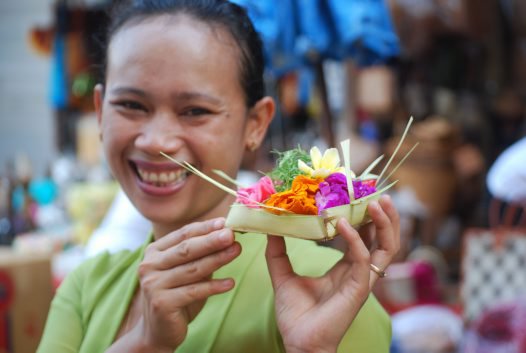For Arts Sake! – Visiting Bali #8
The Ubud market, on the outside, appears as if it was trading in art and craft only, and therefore is frequented by tourists and small entrepreneurs. Inside, people sell and buy food, clothing and some other articles of daily use. A great variety of vegetables and fruits are on offer as well as fish, chicken, ducks, meet, sausages, eggs, honey and sweets of all descriptions. Among many tropical fruits there are mandarins imported from Australia and red apples from California, specifically for their bright colours. The people are particular about food presentation, especially for ceremonial offerings. For that matter colourful petals of various flowers are also sold for offerings which are made daily as well as on special occasions. Some stalls sell spices, pepper, chilli, nutmeg, ginger, cloves, peanut, saffron, cinnamon, and a lot more.
Although tourism contributes the lion’s share of income to the Balinese economy, the agriculture, especially rice growing, provides work for the majority of people. There are many who grow small amounts of crops such as fruit and vegetables as well as cash crops such as coffee. Poultry and meat is often provided by small farms. Fish and seafood often come from the small fishing communities along the coast.

© Australian Museum
So, people come to the market to sell and convert the fruits of their labour into money. They have to pay bills and for the education of children (from secondary level), the cost of transport and other life necessities. Small farmers are members of water societies that not only provide and maintain very complex and efficient irrigation systems but also a sense of communal work. Known as the Subak Abian system it promotes happiness through good relationships with gods, other people and the environment.
The other group of sellers include artisans who produce an impressive array of goods including fabric and clothing, shoes and bags, head ware, jewellery, wood and stone carvings of all descriptions, paintings, fragrant oils, and more. While many of these products are intended for tourists, some are bought by Balinese to redecorate their temples and homes. Throughout Bali there are villages specialising in stone or wood carving, silver jewellery, paintings, and other forms of craftwork – tradition that has continued for centuries.
Sellers are predominantly women. The older ones have their regular spot at the market for decades. They are the soul of the market – a living witness of history. Some could remember the early decades of the 20th century and, possibly, the ancestors of the royal family – in the palace, just across the road from the market.







